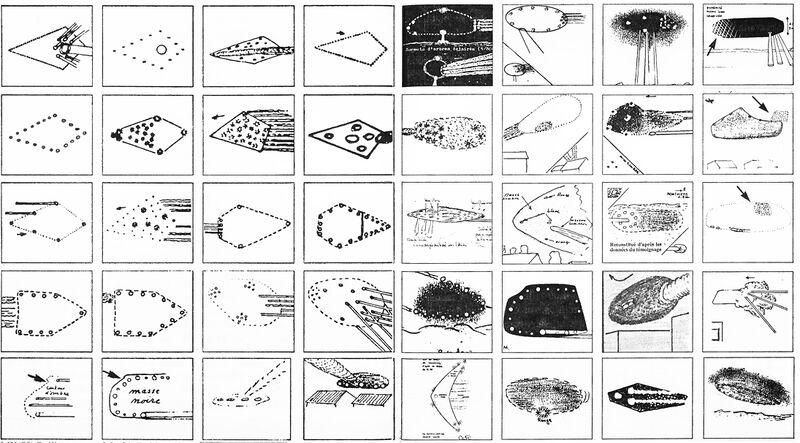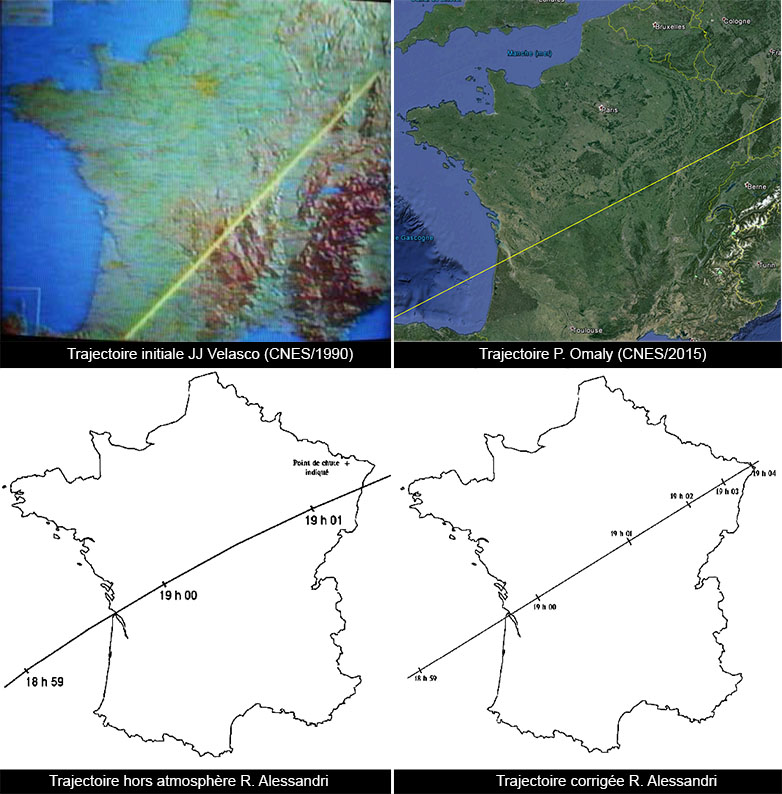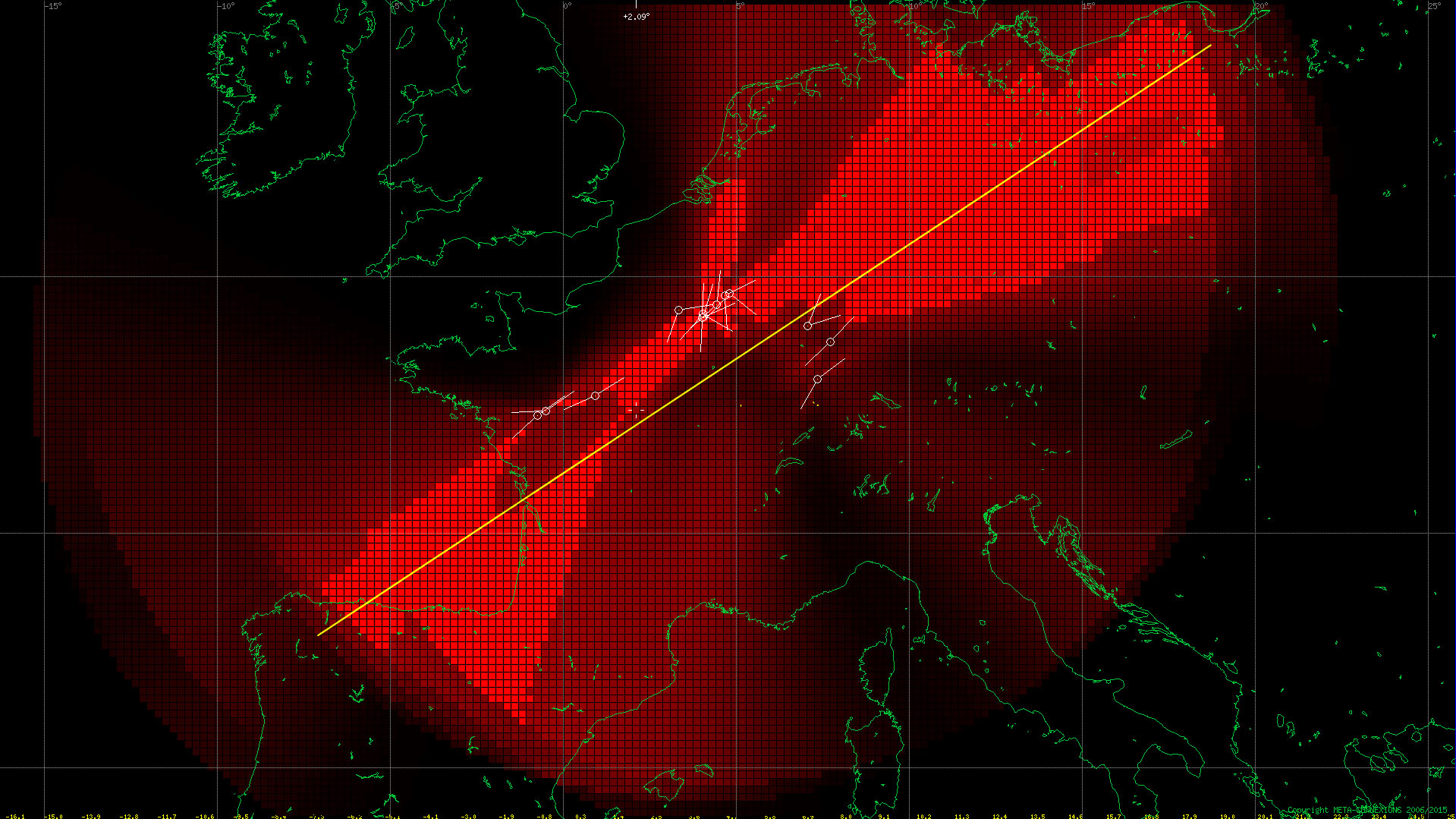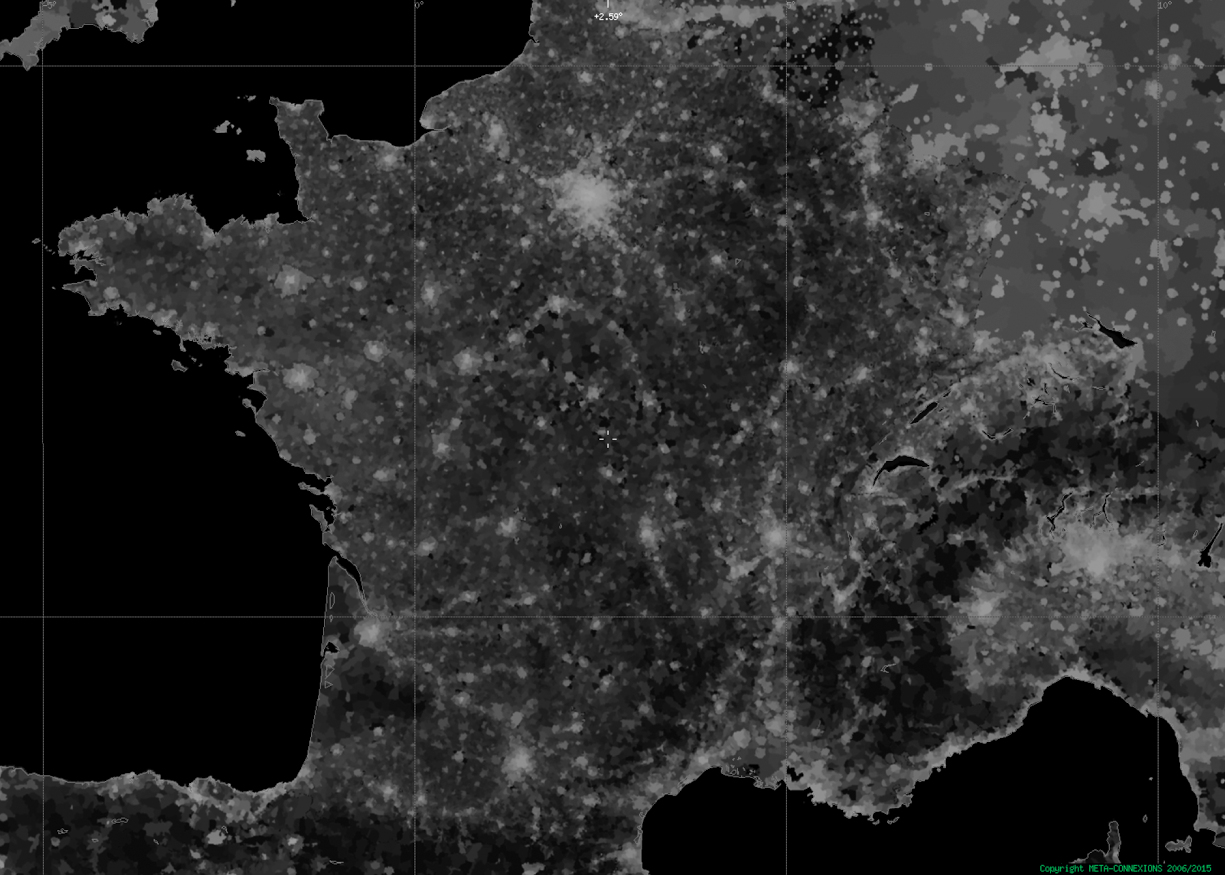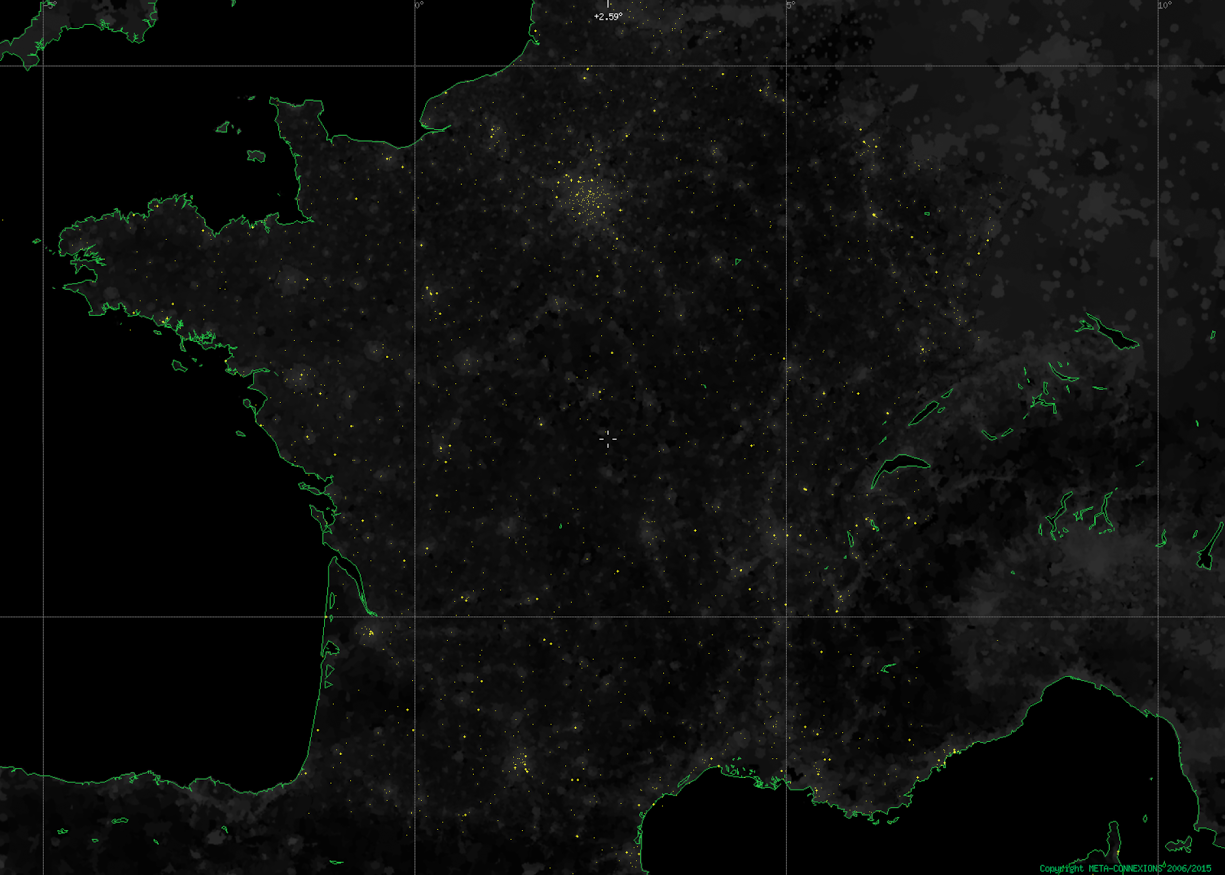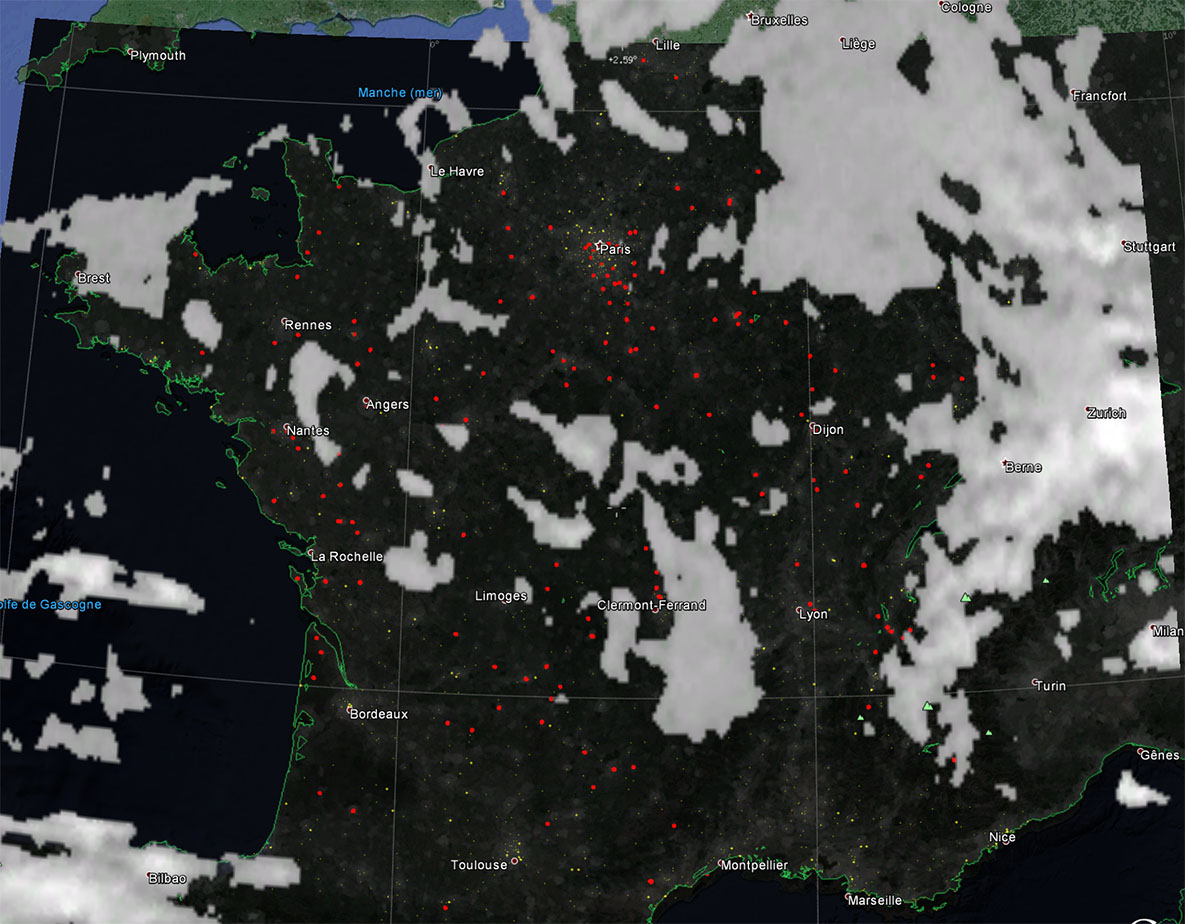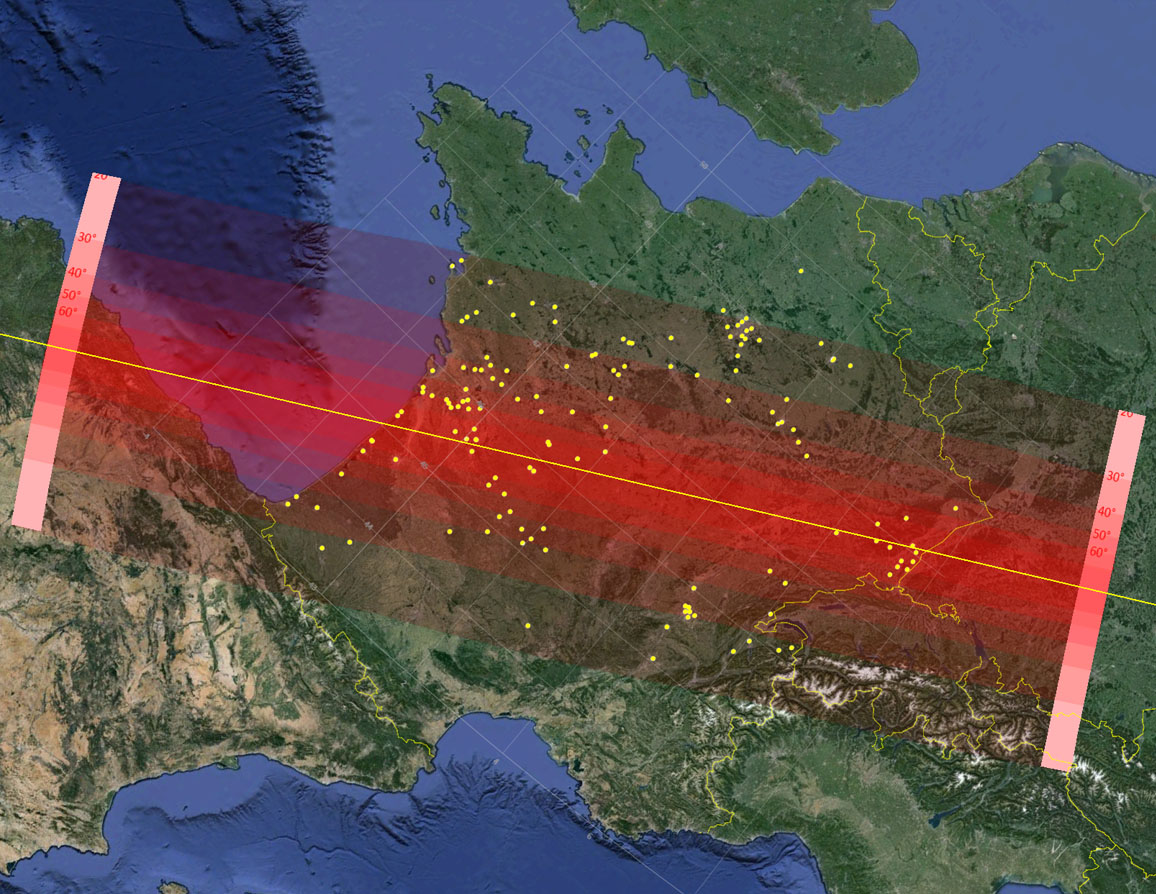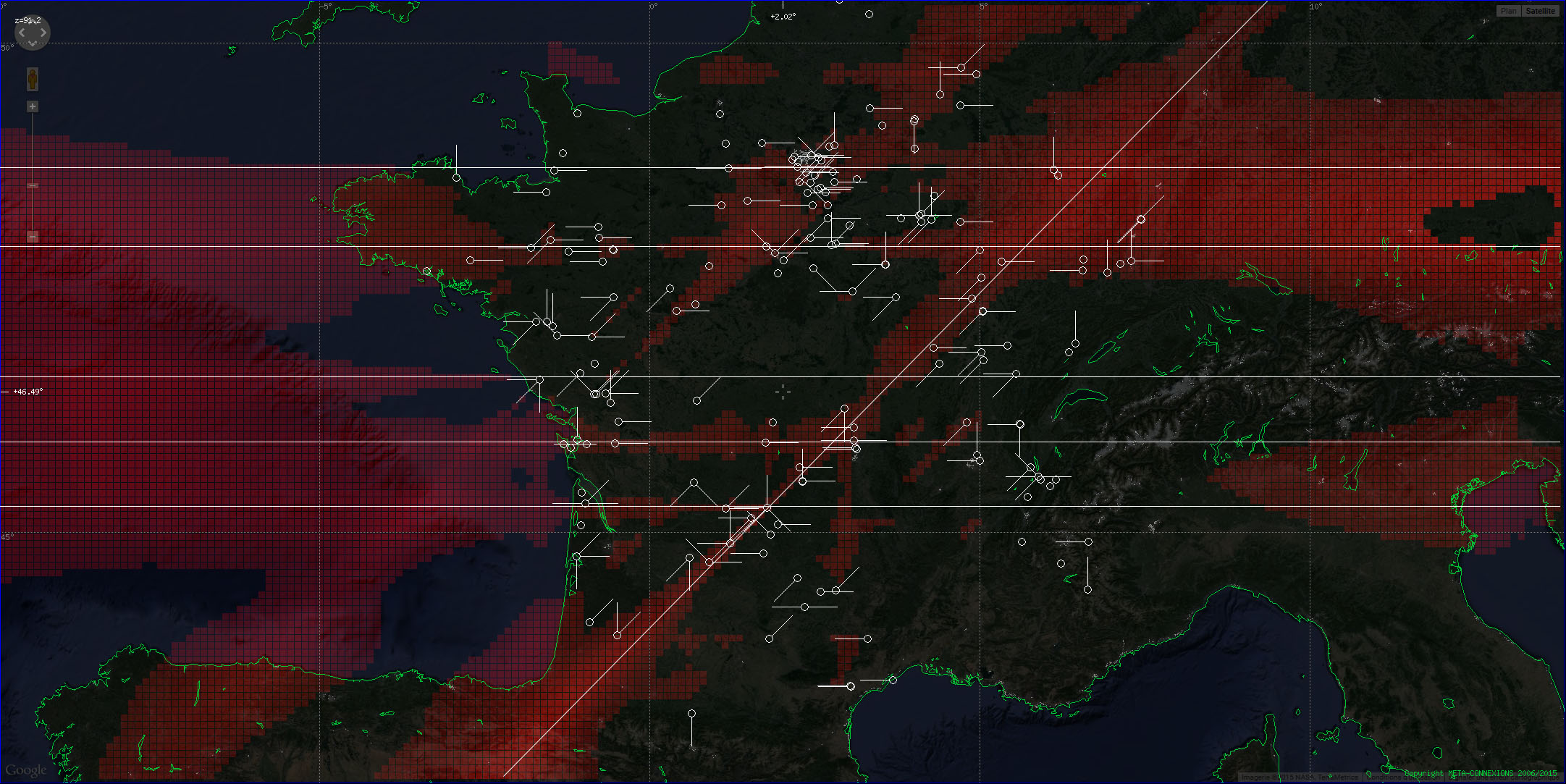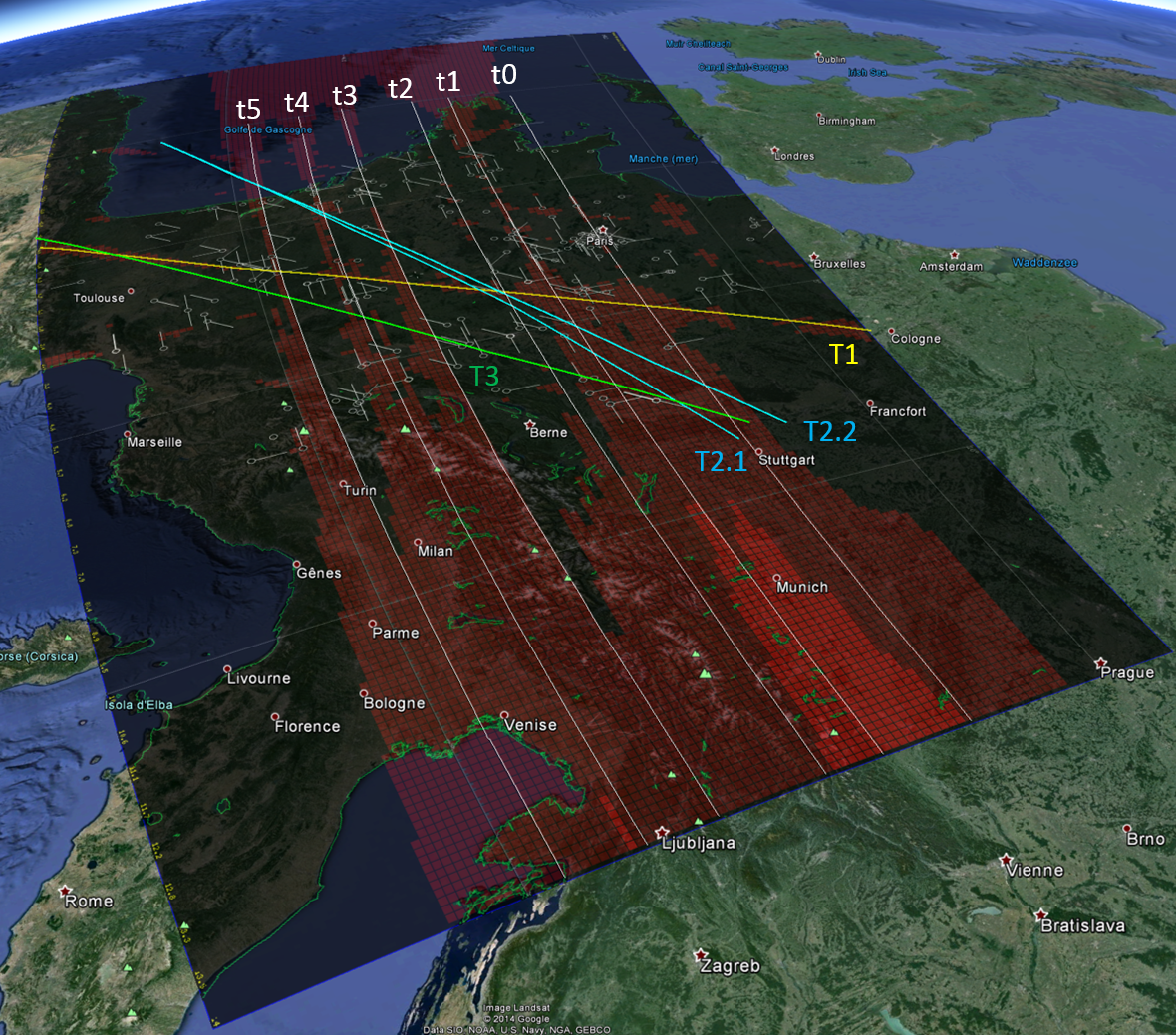Atmospheric reentry of 05-11-1990
Sommaire
- 1 The Event
- 2 The problem posed by the start of the new school year on November 5, 1990
- 3 Which official trajectory?
- 3.1 The trajectory from the orbital data
- 3.2 The trajectory from observation data
- 3.3 1. Spatial distribution of witnesses
- 3.4 2 Elevations (Angular Heights)
- 3.5 3 The probability of presence of the phenomenon on the territory, obtained according to the directions of observation of the witnesses
- 3.6 4 Distribution of the horizontal directions (along the cardinal directions)
The Event
It is 7 p.m. on November 5 when the CNES security services are overwhelmed with calls from numerous gendarmerie brigades reporting a strange luminous phenomenon which crossed a large part of France around 7 p.m. For more than a week, the SEPRA will receive many calls from witnesses asking for explanations about "a huge luminous triangle" which crossed the sky.
Among the witnesses J.P. Haigneré, astronaut at CNES will confirm the strangeness of the phenomenon. At the Aire sur Adour balloon launch center, technicians will delay a launch to observe the phenomenon!
NASA's response arrives on November 8 indicating, for November 5, the reentry of the object "20925/1990 – 94C / GORIZONT 21 PLATFORM / USSR".
The problem posed by the start of the new school year on November 5, 1990
This return to school is a textbook case. I think that if, tomorrow, in France, a similar case occurred, we would certainly still be at a loss to provide a satisfactory answer to the witnesses. That is to say, not simply to answer them:
"Here it is such a rocket because it is the object which entered at that moment!"
But rather to explain to them why:
"You observed these lights/colours/shapes/cloud because..."
In general, it seems to me essential to succeed in making the data and the scientific knowledge that we have of the phenomena coincide with the observations and not to consider that these are two sealed zones.
However, to this day, there remain many witnesses convinced that what they saw cannot be an atmospheric re-entry of a Russian launcher stage and many scientists who only look at their orbital data without wanting to take into account all the observation data (or only certain data which suits them). However, it must be recognized that the models of atmospheric fragmentation existing to date are far too incomplete. No one will be able to deny it: it is extremely difficult to manage to model what happens in the atmosphere when a satellite or a bolide enters. Existing software (such as Debrisk at CNES) is obliged to integrate strong working hypotheses.
Consequently, if we do not also try to start from information on the ground, and really make the effort to go into the experience of the witnesses to try to understand why certain things were perceived, and to manage to explain how the most "exotic" elements of the testimonies have been experienced (phenomena of condensation or headlights on the ground, for example), so it will remain a dialogue of the deaf.
Already on the returns of "classic" racing cars the scientific reality struggles to simulate the observations, here it is a rather atypical return, which only happens once every 20 years: unlike the usual racing cars returns ( meteors/meteorites), the duration of the observation is quite long (more than two minutes above France), the trajectory was very tangential to the ground (giving the impression of a phenomenon which is maintained horizontally vis-à-vis screw of the ground, "flying" almost) and the significant dispersion of the debris which left many witnesses appearing to have relatively different forms and manifestations (like the Rorschach spots, everyone was able to project their own ideas and beliefs on them) .
If it is also inconceivable to think that there was no atmospheric re-entry, it seems to me on the other hand very interesting to try to understand why so many people have seen so many different things.
This is why it seems to me a shame to want to dismiss any attempt at research, on the pretext that we "know" what happened. And so, do not try to explain individual realities and observations. As such it is a real subject of scientific exploration, until now relatively ignored.
Philosophy and approach
1. In general, it seems to me essential to succeed in matching scientific data and knowledge with observations and not to consider that these are two sealed zones. However, until today, many witnesses remain convinced that what they saw cannot be an atmospheric re-entry and many scientists look at their orbital data and project simulations of re-entry, without taking into account all the data. observation.
However, if we do not really try to make the effort to go into the experience of the witnesses to try to understand why certain things were perceived, and how to explain the most "exotic" elements of the testimonies (phenomena of condensation or headlights on the ground, for example), then it will remain a dialogue of the deaf.
This is why, it seems to me that a very interesting aspect in the study of these testimonies is that of the psychology of perception, it should make it possible to understand why and how the information was understood/modified/transmitted by witnesses.
2. When looking for evidence or belief, you really need to avoid relying on subjective data or personal intuitions (biases). And, precisely, the observation of November 5, 1990 crystallizes the prejudices; they appear for many people, whether they are "anti" (anti-thesis atmospheric reentry) or "pro" (pro-thesis atmospheric reentry) as "obvious", thereby ruling out any systematic verification, susceptible on its own, to put an end to this debate.
We thus find ourselves faced with two conscious or unconscious mechanisms, when we deal with testimonies, terms evoked at the time by the COMETA report: it is a question of expanding "(dis)information" and "(dis)information reductive": each observer, witness, or investigator, analyst, when he reads or listens to a testimony, will use one or other of these mechanisms in order to bring reality into his pre-conceptions (pre-judgments) and value models.
For example, let's say a witness saw (and described) a black triangle with 3 white light points at the ends and a central red lighthouse. If I caricature, at both ends of the spectrum, some:
- will rather practice reductive de(sin)formation, they will destroy information: your witness saw an airplane! The white end lights alone are retained by the observer/investigator: this is the posture of doubt (more often essentially applied to others than to oneself).
- others will rather practice amplifying de(sin)formation, they will add information: your witness saw an extra-terrestrial vessel! (even if the witness never spoke of extra-terrestrials). Trust granted on principle, with little critical thinking.
Operations on the subjective realities of witnesses to get closer to objective reality. There always is, to some extent. However, these two caricatural examples show that our attitudes can cause deviations from objectivity and above all dangerous postures of affirmation/authority, creating prejudices about reality. It is all the more insidious that most often unconscious.
The question I always try to ask myself is: do I have the right to alter or amputate a testimony, and if I do, to what extent? And how do I justify it? And if I do it once, twice, n times with different testimonies on the same case of observation? This is a matter of academic honesty in handling information about testimonials. Any repetition or abuse of these mechanisms one way or the other should "alert" an investigator. And on November 5, 1990 we are right on it because the beliefs of each other play out.
Sometimes they say "the devil is in the details" and I think that's really the case here.
With November 5, 1990, it's easy to reduce the "inconvenient" details to nothing. But I think that this approach does nothing to solve the problems that this poses for witnesses who do not recognize the phenomenon when they are told that it is an atmospheric re-entry.
This is why it seems interesting to me, already from a statistical point of view, to try to specify and measure what these anomalies represent, and their deviation from normal(ity). What no one has done to date.
Without this, it is difficult to identify the problems posed by the observations and to help the witnesses to reconcile their observations with an objective/shared reality.
Diagram of a "classic" atmospheric re-entry
In general, when a fireball enters the atmosphere, it has a very high speed (in low orbit a satellite goes at a speed of about 8km/s). This speed creates a ball of fire (a plasma composed of atmospheric ions) which illuminates the atmosphere very strongly and can sometimes give the impression that it is day in the middle of the night. This plasma often gives the impression that the bolide is much larger than it is, and above all allows it to be seen at considerable distances, of the order of several hundred kilometers.
This phenomenon starts at an altitude of about 100 km, under the effect of erosion created by the heat and friction with the atmosphere, the bolide weakens and fragments, in a process that can be repeated one or more time. At the end of its trajectory, when the debris has a speed of less than 3 km/s, it generally enters a "dark flight" phase: the plasma can no longer form and it no longer illuminates. At night, the bolide is then generally no longer visible. This often occurs at a fairly low altitude, less than 30 km (and here, in this case, it is a question of dense elements; for satellites or space debris, in general, the altitude of fragmentation retained is much higher high, of the order of 60 km).
During this last phase of the trajectory, the fragments are subjected to atmospheric conditions and the trajectory is all the more altered. Unfortunately, there are only a few rare specialists who have looked into these types of calculations, they remain difficult and above all not very certain: dependent on many parameters including the structural characteristics of the racing car.
When found on the ground, the debris forms a scatter field (http://fr.wikipedia.org/wiki/Champ_de_spersion), which is usually contained in a shape called a "scatter ellipse". The more the trajectory of the fireball is tangent to the ground, the more the field of dispersion is elliptical. Conversely, the more the trajectory is vertical to the ground, the more the dispersion field will be circular. The width and the exact characteristics of the dispersion field essentially depend on the way the meteor will have been fragmented and the explosions that will have taken place in its "flight" phase. The debris does not fall in a "queue leu leu", but in a dispersed manner, both laterally and longitudinally. (unless the racing car remains whole of course).
Which official trajectory?
Oh that ! In fact, that's the whole problem: it doesn't exist for the back-to-school phase. How can the observation of witnesses be compared to an objective reality when the latter has not been established?
The trajectory from the orbital data
We have of course the Two-Line Elements (TLE), a standardized representation of the orbital parameters of objects in Earth orbit. These elements are measured and calculated by NORAD and NASA, not only for artificial satellites, but also for space debris. However, by descending so low in the atmosphere, as was the case for this reentry, the forces of friction but also abrasion phenomena linked to the plasmas created come into play. The resistance of the materials is put to the test , but the behavior of a phenomenon subjected to these forces becomes very difficult to model. Especially since the elements composing the Russian rocket are not distributed and are poorly known to date: they would require in itself, a study for each of them (intrinsic resistance, shape, mass, etc.) allowing a model to be produced design and therefore simulations.
Above, at different times, different trajectories have been proposed.
For the rest, in this document, I used in the representations the trajectory calculated at CNES by Pierre Omaly in 2015.
To calculate its trajectory, Pierre Omaly relied on both the two lines elements, but also the observation of Pierre Neirinck, an astronomer who had sent a precise and detailed report of his observation, notably taking landmarks thanks to the stars (http://www.u-sphere.com/images/1/15/90_11_05_neirinck.gif). He has, thanks to these data, adjusted the speed of descent of the trajectory. At the same time, he created a simplified model of the Russian rocket stage, taking into account that it was a large cylinder made up of 3 highly resistant titanium tanks which ended up falling. He took different assumptions of density / mass for these. Specialized software for calculating atmospheric re-entry (debrisk). This software is indeed able to calculate to a certain extent the effects of atmospheric re-entry and to take them into account (https://logiciels.cnes.fr/content/debrisk). This software then calculated a trajectory that can be exported under Google Earth.
Translation types Text translation Source text 2,371 / 5,000 Translation results
The trajectory from observation data
However, if the Two Line Elements do provide an indication of the parameters before the start of the school year, of what happened afterwards, it is more difficult to elaborate. And that is, I think, the whole point of taking over with ground observations: photos, videos and witnesses of course. Lack of material elements. As we do not have usable photos with precise directions of associated observation nor videos, we must rely on the observations of witnesses.
The report produced by channel 23 gave the opportunity to have the positions and directions of sightings of 13 of the witnesses interviewed, and, starting from there, to calculate the probability distribution of the phenomenon's presence.
A cartographic calculation program that I developed allows me to calculate and represent the probabilities on one. In practice, the software superimposes the directions of observation of each witness, by admitting margins of error around these. This is a form of triangulation which allows taking into account as many observers as desired.
| Witness | Commune | Lat 1 | Lon 1 | Az Start | Az Fin |
|---|---|---|---|---|---|
| T1 | COURCY | 49.315533 | 4.022503 | 221.3 | 119.6 |
| T2 | REIMS | 49.240411 | 4.002733 | 183 | 2.6 |
| T3 | ANGERS | 47.451161 | -0.524814 | 268.4 | 54.9 |
| T4 | THUGNY-TRUGNY | 49.484469 | 4.410233 | 227.7 | 6.1 |
| T5 | REIMS | 49.251801 | 4.044542 | 16.07 | 66.79 |
| T6 | VILLAVARD | 47.744942 | 0.913044 | 245.8 | 58.2 |
| T7 | SOISSONS | 49.380817 | 3.326581 | 199.8 | 80.6 |
| T8 | CHALONNES-SUR-LOIRE | 47.351672 | -0.765461 | 228.2 | 54.4 |
| T9 | BATZENDORF | 48.783455 | 7.70679 | 226.9 | 42.6 |
| T10 | POIX-TERRON | 49.653028 | 4.644668 | 176.2 | 63.8 |
| T11.1 | NOUVION-SUR-MEUSE | 49.695722 | 4.791663 | 222.8 | - |
| T11.2 | DOM-LE-MESNIL | 49.69379 | 4.790163 | - | 127.6 |
| T12 | COLMAR | 48.072769 | 7.325175 | 209.1 | 52.7 |
| T13 | NEUFGRANGE | 49.076842 | 7.041292 | 22.2 | 72.4 |
In principle, we start from observation data on the ground, to go back to the trajectory. Exactly the opposite of the previous techniques, in that they complement each other.
On the map above, the white circles represent the positions of the observers, the white lines the horizontal directions of observation (azimuths). The red squares indicate an intensity, the probability that the phenomenon has passed at this location.
For each observer, an "extinction" of the phenomenon was caused beyond 10° of angular distance, in the frame of reference constituted by the center of the Earth, the witness and the phenomenon. This corresponds to a distance of approximately 1113 km. It is also the maximum distance at which one can see a phenomenon evolving at an altitude of 100 km: beyond this distance, taking into account the curvature of the Earth, it passes under the horizon. However, and generally, the phenomenon is seen when it already has an elevation of 10 to 20° on the horizon. It is therefore closer to the witness (about 350 km for 15° on the horizon) List of residual anomalies (at least, points to be clarified)
As often, I prefer a "holistic" (global) approach to phenomena, in order to avoid sterile debates and endless questioning of individual testimonies: prejudices and the fragility of information mean that individual questioning will always be possible.
To escape this, by cross-referencing information, I try to work with all the testimonies available, in order to bring out "signals". Assuming that in the background noise of the data, perhaps significant anomalies have not been detected.
I have focused here on a list of anomalies, which I consider to be notable statistical deviations. Not that we can't eventually reduce them, but I find it interesting to work on them to try to understand HOW they could have happened.
Concerning November 5, 1990, I worked from two sources of information:
- the GEIPAN database, for the positions of the witnesses and their directions of observation (567 testimonies recorded),
- Franck Marie's book ("UFO contact"): a "bible" in terms of testimonies (414 depositions) which also includes a small part of history. From this base, I did some data-mining by searching for specific keywords.
Based on these data, I wanted to review and specify the geographical distribution of the observations. What I can say, to date, is that surprisingly, a certain number of "anomalies" appear:
- . On the spatial distribution of witnesses: geographical dispersion does not follow that of large cities
- . On the distribution of directions of observation and concerning:
- elevations (angular heights): there are a large number of witnesses (too many?) reporting an observation at the zenith,
- the probability of statistical presence of the phenomenon, according to the directions of observation: in first approach, observations far too dispersed on the territories and not concentrated according to a defined trajectory (contrary to models carried out with re-entries of racing cars)
- the horizontal directions (observation azimuths): there are too many witnesses indicating the North or the South,
These anomalies may mean that the models we have of reality do not coincide with the individual realities experienced by my witnesses. And, without even talking about a "UFO" phenomenon (as some think that an intelligent phenomenon could be superimposed on atmospheric re-entry), this can mean, for example, that the dispersion of debris was much greater than expected.
Which means that we may one day be able to explain them, but to date, without precise knowledge of the behavior of the phenomenon that has entered (i.e., beyond the Two-Lines Elements (TLE) provided by NASA), we can only conclude with difficulty: we are reduced to cross-checking the data of witnesses to get closer to reality.
1. Spatial distribution of witnesses
Translation types Text translation Source text 3,752 / 5,000 Translation results In a study concerning the spatial distribution of phenomena, I had the opportunity to calculate the level of correlation between the distribution of the witnesses of phenomena and that of the population density is extremely strong: for the only PAN D it is- say nearly 400 testimonials, the probability that this is due to chance, called "p-value", is less than 10^-16.
What we can say, reasonably, is that "where there are people, there are potential observers and therefore necessarily more observations"! (quasi-tautological!)
And this is also true in the heart of large cities: urban spaces absolutely do not prevent UAP observations. Certainly, there are many buildings, buildings, etc., but in practice, this inconvenience is nothing compared to the much greater population density (it increases exponentially when approaching city centers).
Visually, if we compare the distribution of phenomena collected at GEIPAN over 40 years with that of population density, the correlation is obvious:
I therefore expected that the distribution of phenomena, for November 5, 1990, would follow the population distribution better than that. In particular, that the large cities located not far from the trajectory are particularly impacted.
Well no, not at all! The map below shows in red the position of the witnesses following the GEIPAN base, in yellow the trajectory reconstructed by P. Omaly, at CNES:
File:Case observation geipan vs pop fr vs testimonial 5 nov 90 cnes.jpg
As we see, the major urban centers in the south of France escape the "epidemic": Bordeaux, Toulouse, Limoges, Clermont-Ferrand, Poitiers, Châteauroux, Bourges. But also in the east of France.
Statistically, according to the probability stated above, it is quite difficult to understand. For example, why does Bordeaux, which is so close to the trajectory, escape it? Of course, there were certainly observers in Bordeaux, but what is difficult to understand here is why the statistical distribution of the population of observers is so little marked in the big cities? In general, apart from the Paris region (with however a curious asymmetry, the observers being in the southern region of Paris), the spatial distribution of the observers is only slightly correlated with the population density. Conversely, there are concentrations of witnesses in sparsely populated areas, such as around Brive-La-Gaillarde (and this is also obvious with the geographical distribution of Franck Marie's testimonies).
It would be interesting to calculate the probability that this distribution will arrive by taking the 567 GEIPAN testimonies. Similarly, take out the population density profile corresponding to the municipalities of the observers, versus the population density profile of all the French municipalities and compare the layers.
Perhaps the gendarmeries of the big cities received special instructions and did not bring up the testimonies? I wondered if the cloud cover could be the cause of these disparities, but it seems difficult to incriminate it. We are indeed lucky to have a photo taken by the MVIRI instrument of meteosat-4, at 18:00 UT (19:00 local) in wavelengths between 10.7-11.9 micrometers (infrared). The position of the observers is generally quite compatible with the position of the clouds. In addition, the major cities mentioned above are also outside the cloud cover:
2 Elevations (Angular Heights)
Based on Franck Marie's database, I filtered out the only witnesses who reported the phenomenon at the zenith: a significant proportion of witnesses reported the phenomenon at the zenith compared to their distribution throughout France: 145 out of 414, or 35%.
To check the difference between these elevations and reality, it is easy to create a calculation table that indicates the elevation (angle) under which the witness should observe the phenomenon. Should, according to the trajectory, again calculated by P. Omaly.
Thus, for a phenomenon evolving at an altitude of 90 km:
| El. (deg) | Dist/trajectory | Err/Zenith |
|---|---|---|
| 80° | 16km | 10° |
| 70° | 32km | 20° |
| 60° | 52km | 30° |
| 50 | 75km | 40° |
| 40° | 107km | 50° |
| 30° | 156km | 60° |
| 20° | 247km | 70° |
| 10° | 510km | 80° |
Ex: if the witness is 16km from the trajectory (horizontal distance), he should see it at 80° elevation. If it indicates "Zenith" it makes an error of 10 degrees.
I have represented on the map below, in PJ, the trajectory of P. Omaly (CNES) and the elevation below which the witnesses should see the phenomenon according to the distance to it. I have only reported the 145 witnesses who indicate having seen the phenomenon pass at the "zenith":
Following the central red band, assuming a perception error of up to 30 degrees, only 39 witnesses are likely to actually see it "at the zenith". Which means that 74% of the witnesses who indicate the zenith are downright wrong! (30 degrees and more).
| El. (deg) | Number of witnesses |
|---|---|
| 80° | 11 |
| 70° | 15 |
| 60° | 13 |
| 50 | 14 |
| 40° | 17 |
| 30° | 29 |
| 20° | 43 |
| 10° | 3 |
And even: 43 witnesses report the Zenith while according to their position, the phenomenon should be at 20° at the level of the horizon (very low)!
The error distribution profile (in elevation) is absolutely not Gaussian (no "bell curve"). This is partly normal because the surface on the ground from which the phenomenon can be seen under a certain angle increases with the distance to the trajectory. However, the concentration of witnesses declaring to have seen the phenomenon from the azimuth, both at the level of Lyon and Paris is astonishing.
Of course, we can always "reduce" and consider that the witnesses make mistakes and are wrong. And besides, there are: the angular heights are always difficult to estimate by the witnesses. They are also not accustomed to the concept of "zenith": in a simple way, witnesses to whom we ask to designate the zenith could easily be mistaken by 30 to 40°.
However, the azimuth errors extend generously north and south of the recognized course. And, if there are errors, they should be relatively distributed around the trajectory, but this is not the case: if we take a linear regression, i.e. we seek the average trajectory which best represents these observers for whom the phenomenon passes in azimuth, then, we would have a phenomenon entering France further north, at La Rochelle and leaving France at Mulhouse, slightly further south .
Again, this is probably a symptom of poor modeling of the phenomenon's trajectory. This one was probably already fragmented above the Atlantic, and had to present a fairly significant lateral dispersion (North-South).
In the field of the psychology of perception, this aspect should be one of the points to be analyzed and qualified.
3 The probability of presence of the phenomenon on the territory, obtained according to the directions of observation of the witnesses
As I did previously with the data provided by CAPA, I wanted to reconstruct the trajectory of the phenomenon from the GEIPAN database.
The statistical distribution of the observation azimuths of each observer shows privileged areas which form a sort of "grid" on French territory (partially materialized by the longitudinal white lines and the diagonal below; I have filtered the data statistically too weak):
On this diagram, the testimonies of the GEIPAN are represented by white circles and the lines which start from them correspond to the directions of observation (azimuths of observation). Unfortunately, these azimuths are displayed in "steps" of 45°: in fact, in the GEIPAN base, "rounded" directions have been recorded corresponding to the eight main cardinal directions (N, NE, E, etc.), the base of historical data not allowing to record decimal values (!)
This approximation of reality makes any interpretation highly risky.
In the meantime, perhaps, the main useful information of this type of graph, (until working on a precise azimuth database), is that there is no clear convergence in terms of direction. Which is quite different from a re-entry of a classic atmospheric racing car, if we had to compare.
4 Distribution of the horizontal directions (along the cardinal directions)
In the meantime, to try to verify (or invalidate) these results, I tried an inverse methodological approach: try to simulate the distribution of all the observation azimuths that exist in the GEIPAN database. In fact, the distribution of observation azimuths (graphic in the form of a radar) has a rather particular form: that of a "bow tie", with preferred directions along the WSW and NNE directions (28° precisely, i.e. at almost the normal trajectory of the reentry! A reassuring fact from this point of view!) and, which, orthogonally, presents a pinch:
So I tried to re-obtain this graph, starting from supposed trajectories (that of Alessandri, Velasco, etc.), and to calculate what would be, for each observer, the azimuths of the start and end of the observation? And for all the observers, what distribution of observation directions should I obtain?
I was thus able to evaluate the different trajectory models proposed and check their level of relevance. I tested the following 3 models:
- T2.1: a trajectory with atmospheric braking (R. Alessandri) (T2.2 without braking)
- T3: the trajectory provided by JJ Velasco (who had, at the time, indicated that it passed over Pau) (map presented at the time on ARTE in PJ)
- T1+t0+t1t+t2t+t3t+t4+t5: the results emerging from the geostatistical calculation of the directions of observation, a model with 7 superimposed trajectories, denoted: T1 for the diagonal (in yellow) and t0 to t5 for the parallel (in white). (note that there seem to appear other lines parallel to T1, towards the west).
[TO BE CONTINUED]
